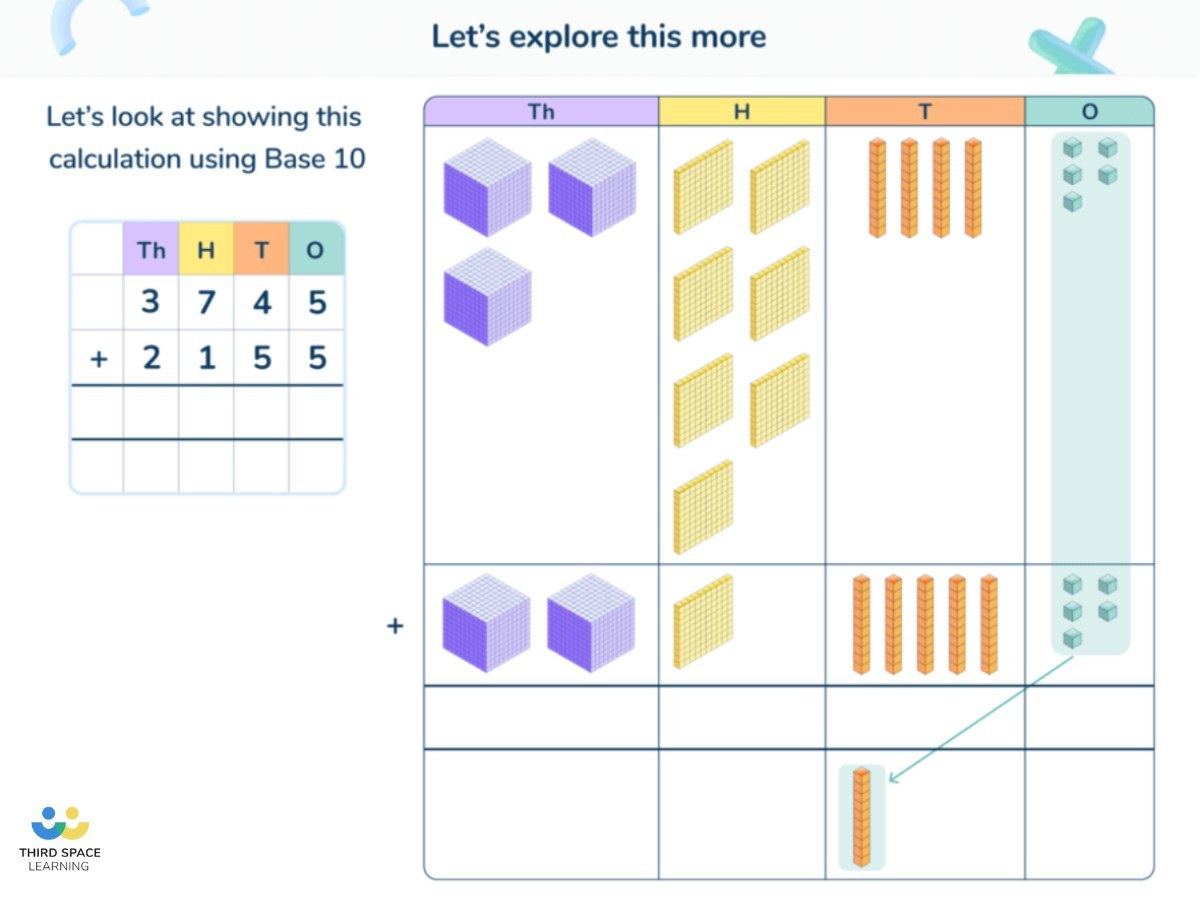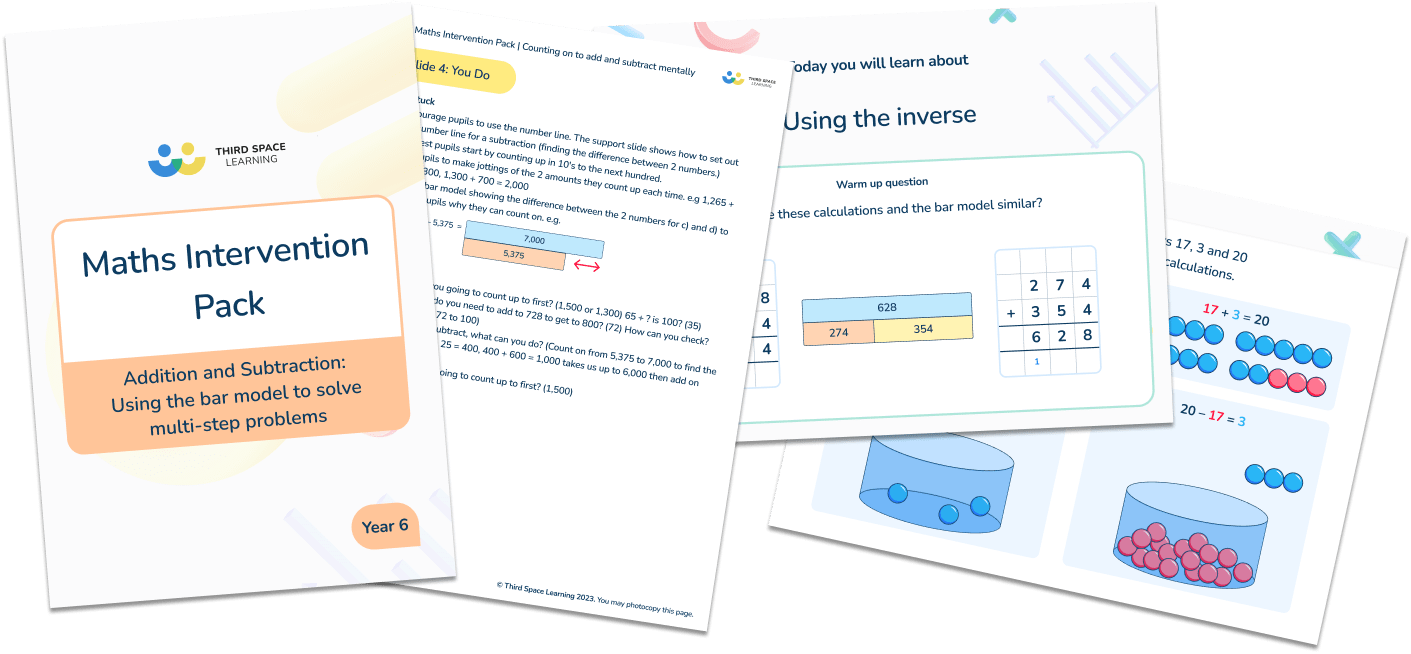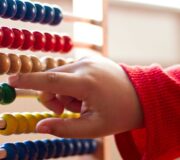Year 5 Addition And Year 6 Addition Interventions: How To Identify and Fix The Most Common Gaps
Have you been wondering how to teach Year 5 addition and Year 6 addition? If the answer is yes, then you’ve come to the right place!
This is the first post post of our interventions bootcamp series.
They’re designed to help Year 5 and Year 6 teachers, Maths coordinators, intervention leads and SATS booster group leaders support Year 5 and Year 6 pupils achieve their national curriculum age related expectations and make good progress in their final years of Key Stage 2. This should then stand them in good stead in the lead up to the KS2 National Assessments.
Are you teaching addition and subtraction to KS2? The differentiated guidance is particularly aimed at those running interventions in school but is also relevant much more widely to your whole class teaching to help you ensure each child is getting appropriate support and being challenged at the same time.
Structure of this Year 5 and Year 6 Addition Intervention Plan
1. First you’ll diagnose where children are struggling with ‘the nuts and bolts’ of that area of Mathematics from the national curriculum.
2. Next you’ll track back to the different stages of understanding and examine what the misconception might be in detail.
3. Finally we’ll give you differentiated strategies that can be used with whole classes, booster groups or alongside 1 to 1 interventions.
We help you solve problems such as
• Why do my pupils keep making mistakes with their carrying/exchanging?
• Why don’t they just line them up correctly?!
• How can I stop decimals or money throwing my class off of the right answer?
Maths Intervention Pack Addition and Subtraction
Download these intervention lessons to help your pupils develop their knowledge and understanding of addition and subtraction.
Download Free Now!Before You Start: Work Out Pupils’ Key Misconceptions With Addition
The first step is diagnosis. From the below children, find the best fit for those you are looking at. Then use this to guide where in the post to read for support:
Kiaan is quiet and studious. He knows some number bonds to 10 and 20 but doesn’t recall many instantaneously. He quite likes using the column method for addition but only seems secure when there is no carrying/exchanging.
In situations where there is some, he will sometimes, for no apparent reason put a ‘1’ under a column. Sometimes this will be the same column as he is adding up. Other times he will not put a ‘1’ under any column.
Although out of this habit now, at the start of the year when using written addition he would often total the tens in 4671+3185 as 15. He would also sometimes write the tens and ones as …1506.
Stage: EMERGING
Read more: Column Addition and Column Subtraction
Talisha can recall many addition facts to ten and relate them to 20. She seems to get things quickly but makes seemingly silly errors and needs to improve her levels of accuracy. When using the formal written method of addition, she occasionally makes errors with her exchanging. She usually forgets to put a ‘1’ or puts it under the same column she is adding.
When she forgets the ‘1’ she usually still gets the calculation correct. She always chooses this method correctly when solving problems with whole numbers, however she sometimes makes errors when decimals are introduced. This is usually around zero as a placeholder.
Stage: DEVELOPING
Zack is speedy with his recall of addition and subtraction facts to 10 and can relate these to 20. He seems competent at written methods but will seemingly randomly make errors with his carrying/exchanging. He enjoys maths and is very competitive.
However, he is easily frustrated and doesn’t enjoy applying his learning or problem solving. He prefers doing things mentally when given the option.
Stage: SECURING
Emily struggles with addition number facts to 10. She finds it hard to relate these to 20 (4+3 to help understand 14+3). She appears under confident in many areas of Maths and doesn’t like being put under pressure or getting things ‘wrong’. She relies on a teaching assistant and even with that support, frequently struggles to grasp year group expectations, even simplified to her level.
When she ‘gets’ an objective, this is often through repetition rather than a deeper understanding. She is rarely able to apply this in different contexts or problem solving. Stage: PRE-BOOSTER
For a more personalised diagnosis of a pupil’s misconceptions in addition, download the free Addition and Subtraction Diagnostic Quiz for Year 6.
Year 5 / Year 6 Addition Emerging
For a child like Kiaan, although he is not fluent with number facts to 20, the focus of the booster should be on developing understanding of how to use the written method of addition.
Read more: What Is Subitising?
What about their bonds and number facts?
Some aspects of a pupil’s maths fluency don’t need to be taught through resource intensive boosters. Practice of number facts can be done just as well, if not better, using online maths games and maths worksheets.
Additional time outside of English and Maths could be given for children not secure on facts to repetitively practise using addition and subtraction worksheets or online packages and apps such as Numbergym Bond Builder or Mathsframe.
Step-By-Step Carrying / Exchanging Using Straws
1. Go back to the beginning of carrying/exchanging by using straws to demonstrate and let children practice the process.
2. For example, in 47 + 25, have straws in bundles of ten with elastic bands to group.
3. Lay out the straws under the tens and ones with the numbers written down.
4. Move the 7 and 5 from their positions and group them together to make a bundle of 1 ten and 2 ones.
5. Put an elastic band around the ten and model putting that group of ten with the rest of the tens.
6. This last step is key. Children making multiple errors with carrying/exchanging need to fully understand why and when they do so.
7. Give children a short amount of time to do the same with a few calculations just with tens and ones.
Step-by-step Base 10 method
1. Now swap out straws for Base 10, making sure children understand that the long ‘tens’ are the same as a bundle of straws.
2. At this stage, get the children to layout their Base 10 on a HTU place value frame (which can be drawn on whiteboards).
3. Quickly after this, re-introduce the formal written addition layout whilst using the Base 10 on place value grids alongside it.
4. Try by working with the calculation 394 + 143.
5. When the children need to carry/exchange, get them to pull their tens into a separate area, underneath their place value frame. This will help avoid issues with children thinking they are ‘taking away 10’ and ‘adding 10’ which often confuses their understanding.
It can also be linked with the ‘1’ that is representing the carried/exchanged ten in the formal method.
6. If children are putting a 1 under the wrong column, refer them to their Base 10 and ask which column their carried/exchanged group have moved to.
When children can confidently exchange using Base 10 whilst representing their calculations with the formal written method and without making mistakes with their carried/exchanged numbers, they are ready for the next stage of the booster – ‘Developing’.

Year 5 / Year 6 Addition Developing
Children like Talisha, who can recall many number facts but still make frequent mistakes should be working towards becoming fluent and efficient in their use of the formal written method, with minimal errors.
As they eliminate misconceptions and slips they can also work towards applying their efficient use within word problems.
Step by step from Base 10 to worded problems
1. Begin by using Base 10 equipment on place value charts.
Model examples such as 4820 + 1914 with one carry/exchange to begin with to ensure all children are able to make the link between the ‘1’ they are carrying/exchanging in the formal written method and from their use of the Base 10. If they have difficulty making the link, refer back to the emerging stage.
2. The next stage is to remove the Base 10 support. If you have place value counters, these can be swapped out with the Base 10 to introduce an additional stage which will still solidify their understanding of exchanging whilst moving away from needing concrete resources.
If not, children can draw, where necessary, their amounts. This may just be needed when looking at multiple carrying/exchanging or not at all:
3. Children then need practice with increasing challenge when calculating. This is achieved not only by working with increasingly large numbers. It is recommended that difficulty is judged by the complexity in carrying/exchanging rather than the size of number. For example, 9164 + 948 is more challenging than 38,472 + 32,259.
Ensure at all stages that children are lining up their columns correctly and their exchanged digits are in the correct columns. Where this is a problem, refer back to Base 10, place value counters or drawn Base 10.
4. Now you can start begin to introduce word problems involving formal written addition so children do not see this method in isolation from the type of questions they will get at end of year tests. The occasional subtraction or multiplication problem could be given (without having to calculate) to ensure children are actually having to think about if the method being learnt is the correct one to use.
If children struggle to see the addition word problems and your children are familiar with bar models, get them to speedily draw one in order to visualise the problem. Once children like Talisha are able to calculate with a good level of fluency and accuracy, they are ready to secure their understanding of addition.
Year 5 / Year 6 Addition Securing
The kind of booster that a child like Zack needs is less step by step, and more like support. This enables him to make good choices around when to use the written method of addition and apply this to different contexts such as multi-step problems and missing numbers.
A simple and key strategy at this stage is to present calculations horizontally rather than in the vertical written method form. Many children will see this as an instruction to calculate mentally, particularly if they are strong in mental arithmetic.
Where this occurs, encourage the children to look at the columns (potentially re-writing vertically) to look for carrying/exchanging.
Guide the children based on how often this occurs to use either a mental or written method.
It is of course important that children do not use written addition when it would be a more efficient calculation if done mentally. However, for children in a booster, it is counterproductive if their mental maths is not strong to ask them to move away from their preferred written method.
Instead, build their speed and accuracy with the written method.
Introduce A Range Of Contexts And Units
The children should be given a range of contexts for their calculations such as the use of distance, mass and capacity where unit conversions can also be brought in to add a layer of complexity. Encourage children to make jottings to the side when they are converting.
If the introduction of different units throws the children, ensure you are giving them bare practice calculations such as 5643m + 3589m at the same level they have been practising before introducing word problems or unit conversions.
Money introduces decimals and is a further stage. For some children, they may need to use plastic or real money on a place value frame. If so, use the strategies discussed earlier but in a money context to enable their understanding.
In short, the children simply need to understand that the decimal place is fixed. To aid this, get them used to drawing the decimal place in the formal written method answer box before they have begun answering it. This is the same in a money context or with any larger decimals.
If you are looking for a concrete resource to help cement this, could also try the free Place Value Concertina resource on these children to clarify the position of the decimal point as it’s a resource that proves very effective with all age groups.
Other articles in this ‘Year 5 and Year 6 maths interventions’ series
- How to teach addition KS2
- How to teach subtraction KS2
- How to teach fractions KS2
- How to teach place value in year 5 and year 6
- How to teach algebra KS2
- How to teach multiplication KS2
- How to teach division KS2
Don’t forget your free downloadable maths resources…
Most children are able to complete simple addition by the age of 5 but children may understand this concept at an earlier age. The national curriculum requires Year 1 pupils to be able to read, write and interpret mathematical statements involving addition signs.
Children struggling with addition may not have developed sufficient number sense. Children struggling may need to explore and play with numbers and practice counting before moving on.
DO YOU HAVE STUDENTS WHO NEED MORE SUPPORT IN MATHS?
Every week Third Space Learning’s maths specialist tutors support thousands of students across hundreds of schools with weekly online maths tuition designed to plug gaps and boost progress.
Since 2013 these personalised one to one lessons have helped over 150,000 primary and secondary students become more confident, able mathematicians.
Learn about the scaffolded lesson content or request a personalised quote for your school to speak to us about your school’s needs and how we can help.





